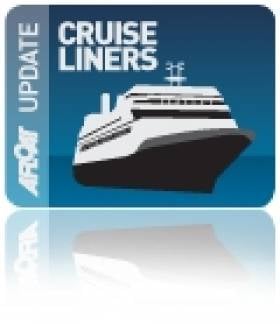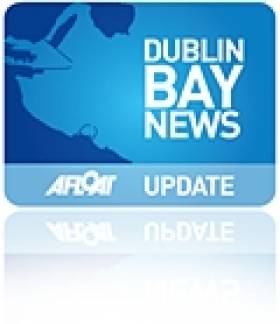Displaying items by tag: Poolbeg Marina
Dublin Port: As You’ve Never Seen It Before
On board the open-topped yellow tour-boat RIB, an audio commentary firstly informs you about the M.V. Cill Airne, built nearby in the old Liffey Dockyard, nearly fifty year ago. Discover why she was one of the last riveted built vessels in Europe, her days as liner-tender and the rich and famous who threaded her decks.
Heading downstream the former lightship Kittiwake is berthed opposite the O2 Arena. She was one of the last lightships to serve in Irish waters at the South Rock station off Co. Down. In complete contrast a ferris-wheel revolves in the background but no sooner the boat slips under the East-Link Toll-Lift bridge which opened in 1984.
On the other side of the bridge a small non-descript looking grey-hulled motorboat lies at anchor, on her bow is painted the figure 11. So what's the story here!...here's a glue: 'Don't pay the ferry man until you get to the other side!...
Past Poolbeg Marina, giant blue-gantries cranes of the Marine Terminal Ltd (MTL) are busy unloading from Karin Schepers, a containership previously reported on Afloat.ie. Look out for the ports 'graffiti', the work of crews who make their mark by painting the name of their ship and also the mural of the late Ronnie Drew of The Dubliners.
Opposite this terminal is the ports largest basin, Alexandra Basin, named after Queen Alexandra. Subject to port security, the tour may include entering the basin should there be a particular vessel of note.This also allows for views of the dock-gates of the Dublin Graving Dock, one of only three large ship-repair facilities on the island of Ireland. Neighbouring the graving dock is where the Liffey Dockyard once stood.
Before the tour passes the towering twin stacks of the former ESB Poolbeg electricity power station is tucked away Pigeon Harbour. Learn more about its hotel conveniently sited beside where packet-ships regularly plied, essentially the ferryport of its day. Its modern-day counterpart faces opposite on the north quays where up to 17 sailings daily operate on the Irish Sea.
Marvel at the length of the impressive Great South Wall, why was it called 'Great' and why was it built?... What can be revealed is that Captain William Bligh of "Mutiny of the Bounty" fame was a major figure in the project, when the wall was completed in 1795.
The commentary has many more fascinating facts, figures and the occasional anecdote told with typical Dublin wit. So if you live within 80km (50-mile) radius of the capital, then the chances that the shirt you wear, the breakfast cereal you ate and the car you drive, most likely came through Dublin Port as almost 75% of goods serve this hinterland.
More on Dublin Bay here
- Dublin Port
- River Lee
- Sea Safari Tours
- Poolbeg Marina
- River Liffey
- Ports and Shipping News
- ESB
- Karin Schepers
- EastLink bridge
- Dublin Port & River Liffey Tours
- Dublin ferryport
- MV Cill Airne
- ESB Poolbeg powerstation
- Alexandra Basin Dublin Port
- Liffey Dockyard
- Dublin Bay boat operator
- Marine Terminal Ltd
- MTL
Bikini Registered Motoryacht Follows Cruiseship Out of Dublin
As for Cary Ali, she is a 87ft long was built in 2007 by Nordhavn to a design of Jeff Leishman. From her stern flew the flag of the Marshal Islands in the Pacific Ocean. Inside the four-decked vessel there is the main salon, a dining room, galley and three guest staterooms, and a master cabin (click HERE). In total eight people can be accommodated. In addition she has a jacuzzi, fly-bridge and is equipped with a tender and has crew of four.
She has a speed of 24-knots and is equipped with 50hp bow and stern thrusters. To read more about the luxurious motoryacht including facts and figures click HERE.
The Cary Ali had berthed at the 100-berth marina of the Poolbeg Yacht & Boat Club which caters lesiure craft up to 20 metres and is centrally located on the south side of Dublin Port. The facility has accommodated larger motoryachts over the years. Though even larger motoryachts such as Battered Bull, a Feadship 52m has berthed further upriver at Dublin City Moorings.
- motorboats
- Carlingford Lough
- Dublin Port
- Cruise Liners
- Ports and Shipping
- Lough foyle
- Poolbeg Marina
- motor yacht
- Marshall Islands
- Dublin City Moorings
- Cruise ships
- Greencastle Co.Donegal
- Greencastle Maritime Museum
- Hebridean Princess
- Caly Ali
- MY Caly Ali
- Charter motoryachts
- Motor boat news
- Lough Foyle Ferry Company
Lecture: “A Hooker Evening with the Men from Kinvarra"
Poolbeg clubhouse overlooks the marina and faces the entrance to Alexandra Basin, where shipping activities of the commercial port can be viewed in closer detail.
To reach the clubhouse which is located on the South Bank, Pigeon House Road, Ringsend, take the Sean Moore Road that connects the Merrion Strand Road (from the south) and the East-Link Toll Bridge (if travelling from the northside).
For further information on the lectures to date click this link and in general about the DBOGA logon here. To contact the PYBC Tel: (01) 668 9983 or logon to www.poolbegmarina.ie/
Lecture: "Childers and the Asgard"
The Dublin Bay Old Gaffers Association (DBOG) are holding their annual Winter /Spring lecture programme in the Poolbeg Yacht Boat Club & Marina (PYBC). The first lecture in 2011 is "Childers and the Asgard - The Enduring Enigma" by Tim Magennis and is to be held on Tuesday 11 January.
The talks proper will begin at 8 pm but the organisers are encouraging those wishing to attend to assemble at 7.15 pm for a socialable drink in advance of the talk starting.
The Poolbeg clubhouse is located on the South Bank, Pigeon House Road, Ringsend which can be accessed from the Sean Moore Road that connects the Merrion Strand Road (from the south) and the East-Link Toll Bridge (from the north).
For further information on the DBOG lectures please contact Tim Magennis on 087 2593113. For information in general about the PYBC Tel: (01) 668 9983 or logon to www.poolbegmarina.ie/
Drilling of Test Boreholes in Dublin Bay
The barge is contracted to Dublin City Council for the drilling of test boreholes in the approaches to and within Dublin Bay in relation to the Ringsend Wastewater Treatment Plant. Both jack-up barges 'Aran 250' and 'Excalibur' will be operating on a 24-hour / 7 days per week basis.
In attendence Sea Safari Tours RIB 'James Joyce', which normally operates as a tourist-sightseeing craft will act as a stanby boat during the rig operations. In addition a buoy will be positioned 300-metres of the barge during drill operations, which is expected to take approximately one week for each drill.
The project will also see the tug, Trojan providing supplies and to tow the jack-up rigs between locations in Dublin Bay. Both the James Joyce and the Trojan will be based out of the Poolbeg Marina, in the centre of the port.
Since the start of October, the project has also required the services of the yellow-hulled catamaran, Xplorer to carry out a bathymetric survey of Dublin Bay.
For further detailed information, please consult Notices to Mariners (No. 14 and 15) listed on the Dublin Port Company website by logging onto this link: http://www.dublinport.ie/information-centre/notice-to-mariners/
In addition to www.dublincity.ie

































































